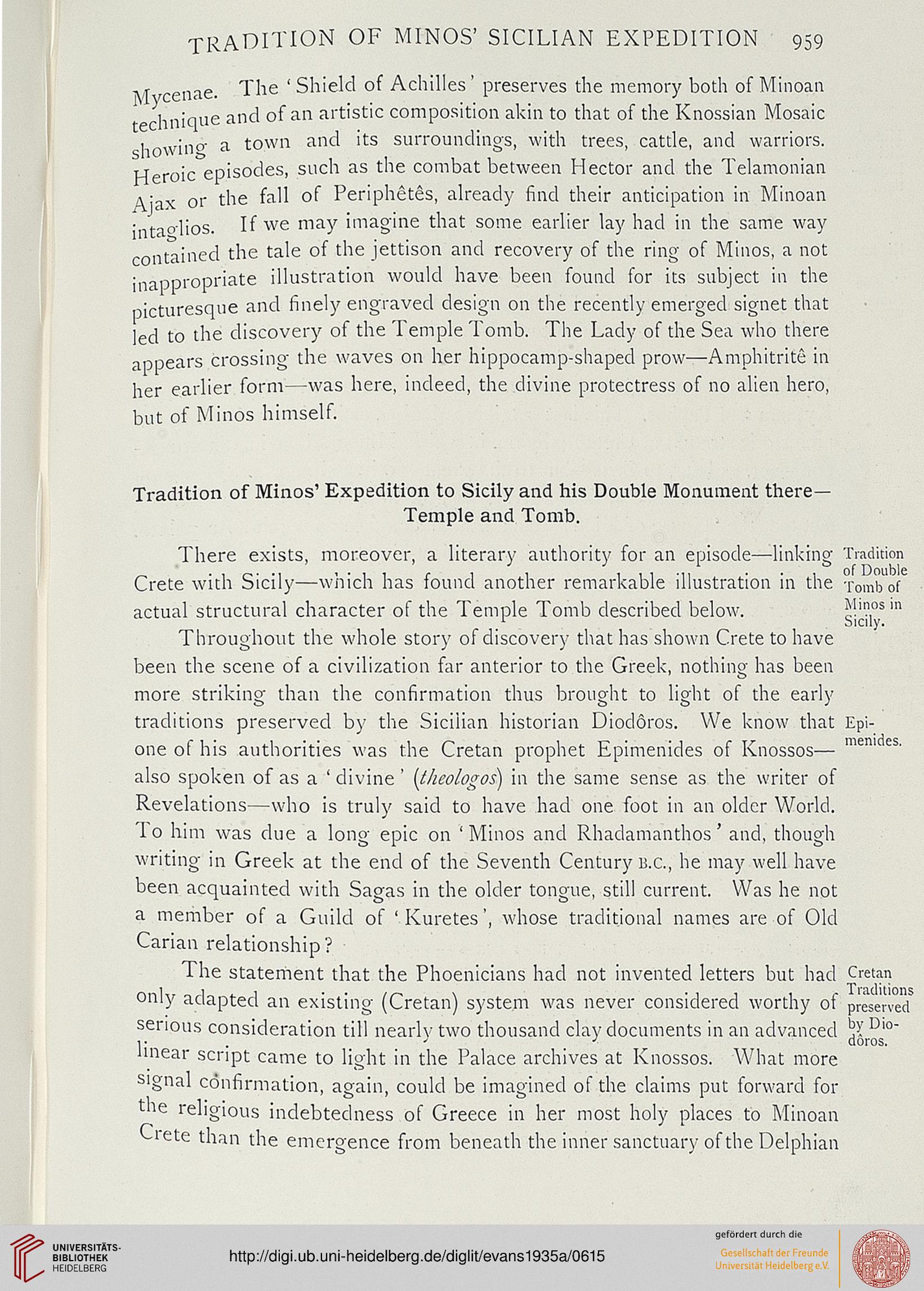TRADITION OF MINOS' SICILIAN EXPEDITION 959
IVT cenae. The 'Shield of Achilles' preserves the memory both of Minoan
1 nioue and of an artistic composition akin to that of the Knossian Mosaic
1 vino- a town and its surroundings, with trees, cattle, and warriors.
Heroic episodes, such as the combat between Hector and the Telamonian
Aiax or the fall of Periphetcis, already find their anticipation in Minoan
• taoiios. If we may imagine that some earlier lay had in the same way
contained the tale of the jettison and recovery of the ring of Minos, a not
inappropriate illustration would have been found for its subject in the
picturesque and finely engraved design on the recently emerged signet that
led to the discovery of the Temple Tomb. The Lady of the Sea who there
appears crossing the waves on her hippocamp-shaped prow—Amphitrite in
her earlier form—was here, indeed, the divine protectress of no alien hero,
but of Minos himself.
Tradition of Minos' Expedition to Sicily and his Double Monument there-
Temple and Tomb.
There exists, moreover, a literary authority for an episode—linking Tradition
Crete with Sicily—which has found another remarkable illustration in the Tomb of
actual structural character of the Temple Tomb described below. *'!,nos'"
Throughout the whole story of discovery that has shown Crete to have
been the scene of a civilization far anterior to the Greek, nothing has been
more striking than the confirmation thus brought to light of the early
traditions preserved by the Sicilian historian Diodoros. We know that Epi-
one of his authorities was the Cretan prophet Epimenides of Knossos—
also spoken of as a ' divine' (tlieologos) in the same sense as the writer of
Revelations—who is truly said to have had one foot in an older World.
To him was due a long epic on 'Minos and Rhadamanthos' and, though
writing in Greek at the end of the Seventh Century B.C., he may well have
been acquainted with Sagas in the older tongue, still current. Was he not
a member of a Guild of ' Kuretes', whose traditional names are of Old
Carian relationship ?
The statement that the Phoenicians had not invented letters but had Cretan
only adapted an existing (Cretan) system was never considered worthy of preserved
serious consideration till nearly two thousand clay documents in an advanced *X D'°"
y J J doros.
linear script came to light in the Palace archives at Knossos. What more
signal confirmation, again, could be imagined of the claims put forward for
tne religious indebtedness of Greece in her most holy places to Minoan
Crete than the emergence from beneath the inner sanctuary of the Delphian
IVT cenae. The 'Shield of Achilles' preserves the memory both of Minoan
1 nioue and of an artistic composition akin to that of the Knossian Mosaic
1 vino- a town and its surroundings, with trees, cattle, and warriors.
Heroic episodes, such as the combat between Hector and the Telamonian
Aiax or the fall of Periphetcis, already find their anticipation in Minoan
• taoiios. If we may imagine that some earlier lay had in the same way
contained the tale of the jettison and recovery of the ring of Minos, a not
inappropriate illustration would have been found for its subject in the
picturesque and finely engraved design on the recently emerged signet that
led to the discovery of the Temple Tomb. The Lady of the Sea who there
appears crossing the waves on her hippocamp-shaped prow—Amphitrite in
her earlier form—was here, indeed, the divine protectress of no alien hero,
but of Minos himself.
Tradition of Minos' Expedition to Sicily and his Double Monument there-
Temple and Tomb.
There exists, moreover, a literary authority for an episode—linking Tradition
Crete with Sicily—which has found another remarkable illustration in the Tomb of
actual structural character of the Temple Tomb described below. *'!,nos'"
Throughout the whole story of discovery that has shown Crete to have
been the scene of a civilization far anterior to the Greek, nothing has been
more striking than the confirmation thus brought to light of the early
traditions preserved by the Sicilian historian Diodoros. We know that Epi-
one of his authorities was the Cretan prophet Epimenides of Knossos—
also spoken of as a ' divine' (tlieologos) in the same sense as the writer of
Revelations—who is truly said to have had one foot in an older World.
To him was due a long epic on 'Minos and Rhadamanthos' and, though
writing in Greek at the end of the Seventh Century B.C., he may well have
been acquainted with Sagas in the older tongue, still current. Was he not
a member of a Guild of ' Kuretes', whose traditional names are of Old
Carian relationship ?
The statement that the Phoenicians had not invented letters but had Cretan
only adapted an existing (Cretan) system was never considered worthy of preserved
serious consideration till nearly two thousand clay documents in an advanced *X D'°"
y J J doros.
linear script came to light in the Palace archives at Knossos. What more
signal confirmation, again, could be imagined of the claims put forward for
tne religious indebtedness of Greece in her most holy places to Minoan
Crete than the emergence from beneath the inner sanctuary of the Delphian




